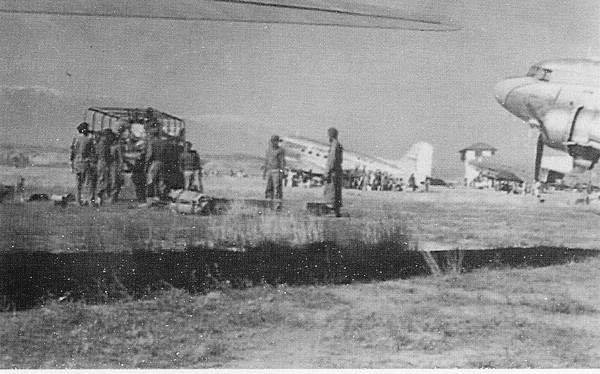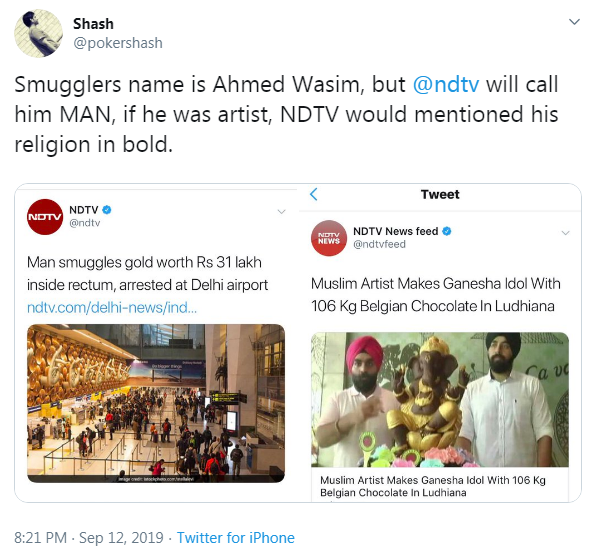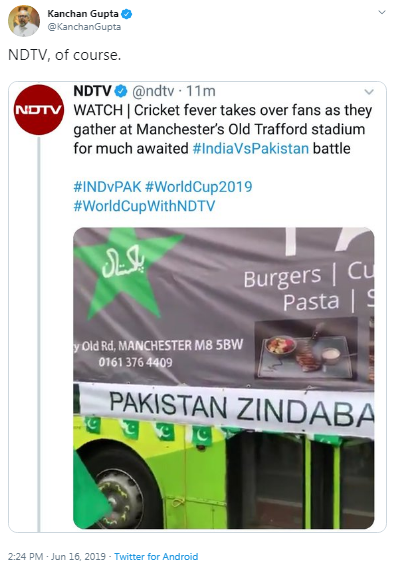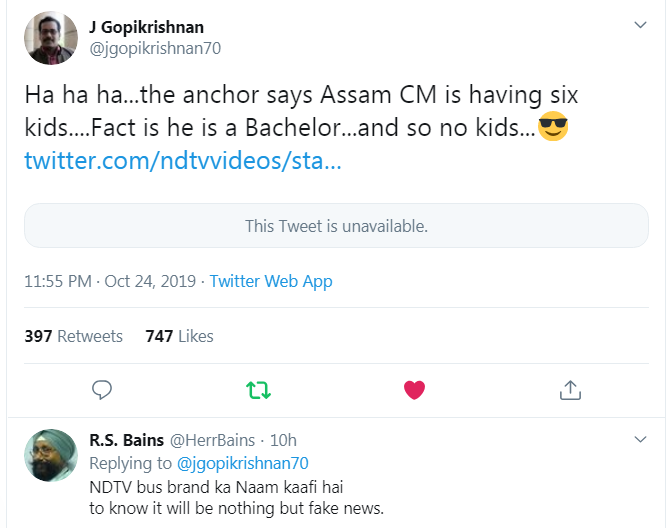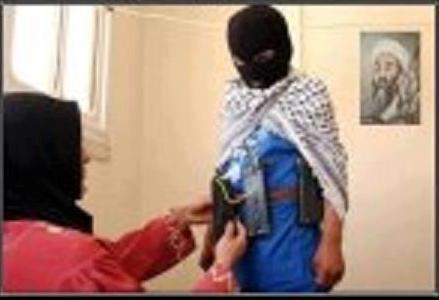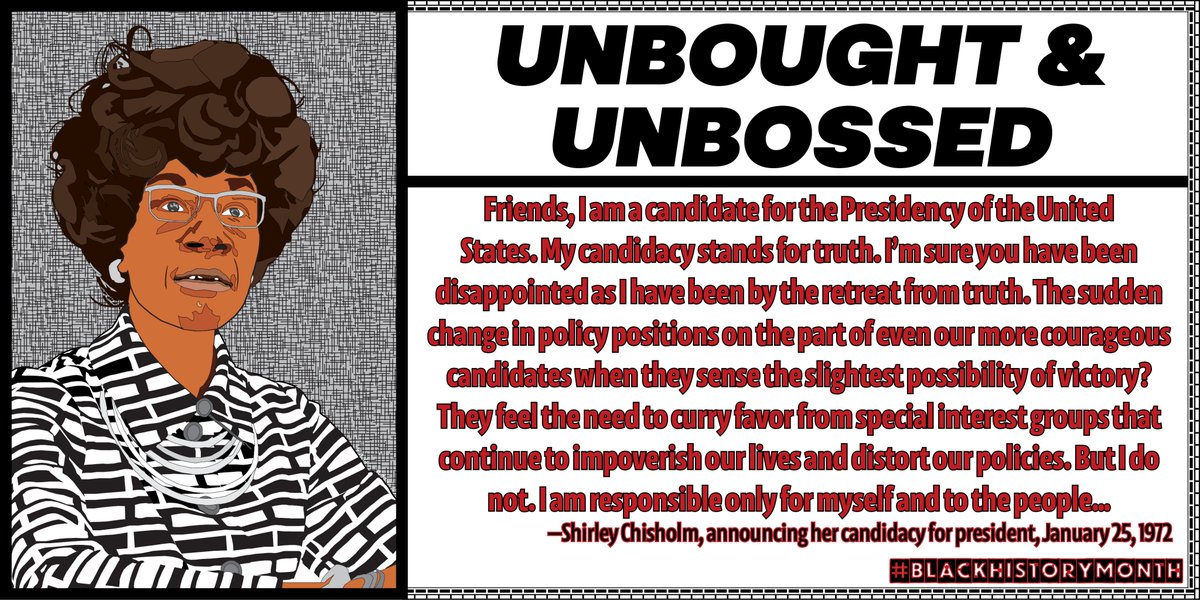Paki raiders were knocking at gates of Uri, having already captured and visited untold horrors on Muzaffarabad and Domel.
Men like Brig Rajinder Singh earned their place in history in battles that would follow.
Baramula was being raped at leisure by those who'd 'liberated' it.
Men like Diwan Ranjit Rai would become legends in days to come.
Major Somnath Sharma was recovering from a wrist fracture.
On mobilization, he would force his way in, going down in glory a week later.
The Maharaja had finally signed Instrument of Accession, making it a part of the Union of India
Indian Army would soon move in
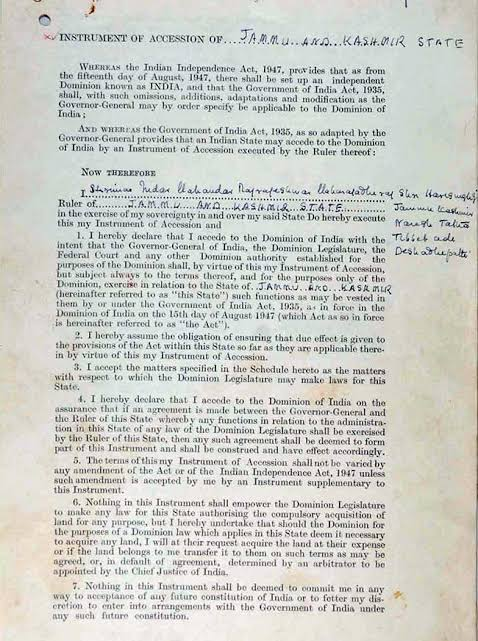
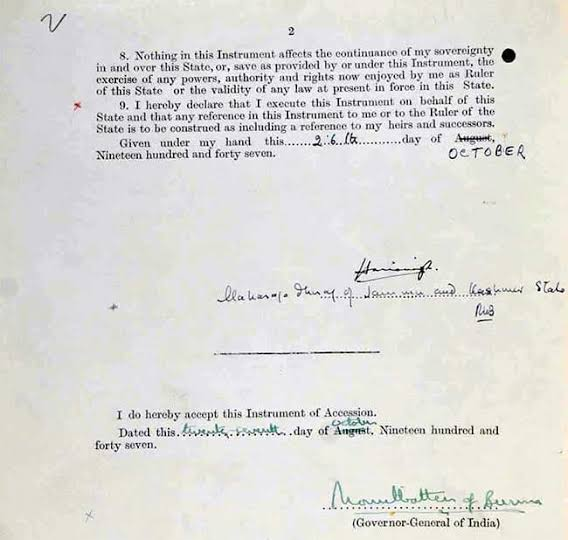
1 Sikh were going about their daily routine in Gurgaon this morning, unaware of the glorious history they were to script less than day later
3 companies of 1 Sikh under Lt Col Dewan Ranjit Rai arrived post haste in Delhi at about 1600Hr, ready to induct into Srinagar the next day.
Commanding Officer 1 Sikh was ordered to report to Safdarjung Airport next morning with all avlbl troops, to be airlifted to the Kashmir Valley
Simple orders to 1 Sikh - Upon arrival at Srinagar Airport, organise its defence and ensure it is free from enemy interference
Braves of 1 SIKH took off from Delhi towards Srinagar Airfield, not yet sure if it was still in own hands
#InfantryDay
1 Sikh troops enroute to Srinagar: The first ones to join what would become an epic campaign!
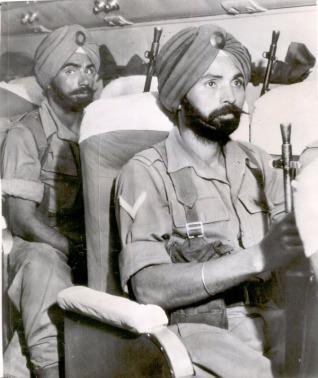
Orders for the 1st aircrft were to circle the Srinagar Airfield first & land only if sure it had not fallen, else go to Jammu
Journey of 1 Sikh: Gurgaon - Delhi -Srinagar - Into the thick of battle - Commanding Officer dead, leading from front.
All within 24hrs
THIS was what it took for them to stake their claim to the land that now belonged to their young Nation
#Respect
Wonder in case Indian Army hadn't landed at Srinagar, would the 'raiders' have liberated Srinagar, or captured it?? #GoFigure
1 Sikh landed in Srinagar with NO info whatsoever of situation on ground and their controlling HQ still building up, back in Delhi
A word of praise for the Dakota pilots - landing at an unseen airstrip of inadequate length, no nav aids & possibly in enemy hands is no small feat, esp for the civilian pilots.
Each and every one of them rose to the occasion & landed with full loads, without incident
^^ A befitting testimony to the courage and grit of these pilots is the fact that they flew from dawn to dusk without a single mishap.
The first Dakota landed at Srinagar at about 9:30am.
By noon, 1 Sikh had built up to 3 companies. Balance troops of 1 Sikh who were still in Gurgaon were being rushed 2 Safdarjung Airport for induction.
The battalion was complete by late afternoon.
State Forces wrongly told Commanding Officer 1 Sikh that raiders had not yet reached Baramula.
He knew instinctively that this info was unreliable.
He was right.
Msg passed thru a returning aircraft that the airfield & Srinagar town were safe for now, though exact location of raiders was unknown.
Instead of waiting for the 'raiders', Lt Col Dewan Ranjit Rai chose 2 move out to seek & engage them, having secured Srinagar Airfield.
It was a bold decision that would secure Srinagar for good, but would cost the gallant soldier his life, leading from the front.
In the meantime, 4 Kumaon & with it, Maj Somnath Sharma, were getting ready to induct into the Valley.
1 Sikh had lost their CO. Major Sampuran Bachan Singh had assumed command in his place.
He too would end up getting shot before the war was over, though not fatally.
Right now, he was organising a defensive line at Pattan.
Due to sudden appearance of Indian Troops, Pakistani 'raiders' were not sure what lay ahead
Unknown to them, route to Srinagar was now CLOSED.
And it has remained closed since.
Meanwhile, 4 Kumaon too had arrived and taken over the responsibility to defend the Airfield.
The raiders were cautiously moving ahead of Baramula to ascertain locations of own troops, torching more villages in the process.
Brig JC Katoch had been placed in command of the now famous 161 Brigade. He flew in to the valley for a quick situation update.
Brig Katoch would get shot in the leg a few days later leaving troops in valley without their commander second time within a week.
Meanwhile, Dakotas continued flying into the valley.
With each landing, the surface of the runway was crumbling just a bit more.
Thick walls of dust now filled the air with each take off / landing at Srinagar Airport with no means of spraying water to prevent further degradation of the vital runway.
1 Sikh had now built up to a strength of 950 men with elements of units arriving from Pakistan allotted to them including remnants of 1/1 & 3/15 Punjab that had come to India after the battalions stayed on in Pakistan + some artillery personnel.
Brig JC Katoch arrived in Srinagar to formally take over command of 161 Brigade.
He would be shot in the leg and have to be evacuated 2 days later.
The overall strength of the Indian garrison within the valley had built up to 2000 men by now.
Having gotten over the initial shock of sudden arrival of Indian troops, the raiders were now probing their positions.
No major engagements yet, but reports of upto 350 raiders advancing from Pattan to Magam to outflank 1 Sikh positions were received.
Ironically, the only incident of note was Brig Katoch getting hit by a stray bullet as he inspected 1 Sikh positions.
Brig Katoch would soon be evacuated for medical attention, leaving troops in the Valley without their commander for the second time in five days.
Brig Kalwant Singh and Wg Cdr 'Baba' Mehar Singh visited Srinagar Airfield.
Kalwant Singh would soon assume command of JAK Force.
In a first, three Tempests from Ambala strafed the raiders between Pattan and Baramula.
Meanwhile four Spitfires and two Harvards were moved to Srinagar Airfield to be based there.
How they managed fuel is another story!
'D' Company of 4 Kumaon under Maj Somnath Sharma arrived in Srinagar. He would go down in glory just two days later.
Meanwhile, Gilgit Scouts 'rebelled' undr Maj Brown & overthrew State Govt reps. This news would be received in Srinagar two days later.
Maj William Brown, the 25yr old commander of Gilgit Scouts was 'unhappy' with the Governor and the State Govt of J&K.
He had already made up his mind. This night would change the fate of Gilgit Baltistan, without any 'help' from Pakistan Govt.
Unfortunately, the law of averages soon caught up with all the sorties headed to Srinagar.
Dakota MA965, piloted by Flt Lt Clifford Joseph Mendoza crashed near the Banihal Pass, killing a total of 25 air force personnel.
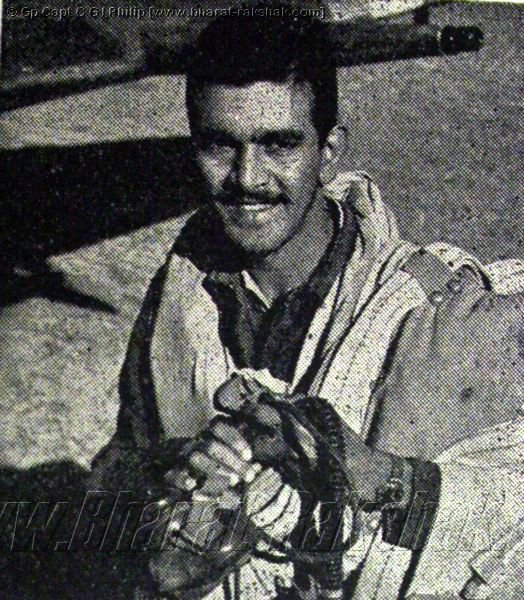
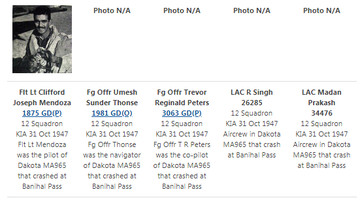
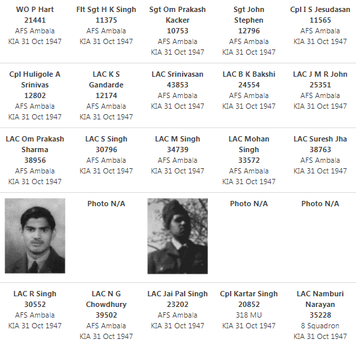
Within a day of Col Bacon, the Brit Political Agent, leaving Gilgit, a 'Palace Coup' of sorts had overthrown the Maharaja's govt.
Last midnight the Governor was surrounded by the Scouts and the next day he was 'arrested' and a provisional government declared.
Hari Singh's nearest forces were 6J&K Infantry at Bunji, 34 miles from Gilgit, mix of Muslim & Sikh troops, under Lt Col Majid Khan.
Muslim soldiers of the 6th Infantry massacred their Sikh brothers-at-arms at Bunji.
The few Sikhs who survived escaped to the hills & from there found their way to the garrison at Skardu.
This garrison would endure for nearly 10 months till they ran out of ammo and had no choice.
Brig Sher Jung Thapa would stand true to his name & earn the grudging admiration of even his enemy.
Maj Brown would later be awarded the MBE by the Brit Govt in 1949 & go on to serve in the British High Commission in Karachi in the 1950s.
The widow of Maj Brown would subsequent be awarded the Sitara-e-Pakistan in March 1994 in recognition of his coup d' état.
Meanwhile in Delhi, Col LP Sen had been told by the Chief that he would be taking over 161 Infantry Brigade in Srinagar.
Col Harbaksh Singh landed in Srinagar and took over the reigns of 161 Infantry Brigade till such time Brig LP Sen came in.
At 0830Hr, a patrol of 1 Sikh was ambushed.
The Khalsas regrouped & killed 12 raiders and captured 1.
They too, however, lost 5 men in the process.
At 3pm, 1 Sikh positions were attacked in good strength by the raiders.
They were beaten back two hours later.
Meanwhile, an unprecedented inter-dominion war worried Britain, esp since Pakistan was a promising prospect as a military ally.
Sir Laurence Grafftey Smith, British High Commissioner in Pakistan wrote to London that 'Rumoured presence of a Sikh Battalion in Kashmir is excessively provocative & would result in the employment of methods of East Punjab in Kashmir by Sikhs and Dogras.
He continued, writing that with Kashmir in Indian kitty, British policy in Afghanistan would suffer
This led to the belief in London that Indian control over J&K would be detrimental for Pakistan and also British interests.
However, the reception of Sikh troops by locals in Srinagar would put paid to this theory of No Sikh Troops permissible in Kashmir.
According to the convoluted reasoning of Noel-Baker, British Secy of State for Commonwealth Affairs, India should have given due warning to Pakistan before flying in troops into Srinagar, and that too NO SIKH TROOPS should have been flown in!
That Hari Singh had actually acceded to India before the troops flew in was of no consequence to this crooked man!
The advance of the raiders towards Srinagar had been checked, but they were still firmed in.
In the coming days they would be met on the battlefield and 'convinced' by the Indian Army to start running back to where they had come from.
But before that they would test the defences of the Srinagar Airfield on final time, earning Maj Somnath Sharma his place in history.
Meanwhile, Brig LP Sen arrived in Srinagar to take over command of 161 Infantry Brigade.
1/2 Punjab, balance of 4 Kumaon and a company of 1 Patiala had arrived in the Valley by now.
The Kashmir front on the whole, was quiet this day.
But it was only the lull before the battles that would commence a day later.
In the meantime, 50 Para Brigade too, been dispatched to Jammu by road.
Due to initial priority being saving Srinagar State Forces garrisons in Kotli & Mirpur had been left to their own devices.
These would continue to remain on the other side of the CFL in 1949.
Thousands of refugees fleeing from the atrocities committed by their 'liberators' sought refuge in the Poonch garrison.
PM of Jammu & Kashmir, Mehr Chand Mahajan made a desperate appeal to Nehru to rescue the beleaguered Poonch garrison.
The IAF was unable to mount any additional air effort towards Poonch
All Chiefs were of the opinion that helping the garrisons at Kotli, Mirpur, Naoshera, Poonch at this time was difficult.
50 Para Brigade was the only hope.
Meanwhile, Brits realized that ordering Brit Officers to 'Stand Down' in the war would have bigger effect on Pakistan than India.
Thus the 'Stand Down' instructions were modified to offset this, with Indian Govt kept in the dark about the same.
The revised instructions on 'Taking the Field Against Each Other' were artfully vague and subsequently interpreted by Noel-Baker in more ways than one, with profound consequences for Kashmir Ops.
Meanwhile, Bhimbar had already fallen at 4am on 28 Oct in an attack in which raiders had used mortars & flame throwers, yet the official line in Pakistan was that there was NO official Pakistani support to the raiders.
The ring around Mirpur was tightening, Kotli, Bagh and Rawalkot garrisons too were heavily besieged.
But except for a single Tempest of No 10 Squadron, Ambala that carried out recce over Kotli, no other operations in their support were possible.
At 8am, Maj Somnath Sharma, 4Kumaon & Capt Ronnie Wood, 1 Kumaon reported to HQ 161 Brigade to discuss the day's patrol pgme.
Maj Somnath Sharma was a veteran of bitter battles in Arakan in WW2.
His right arm was still in plaster due to a hockey injury.
Ignoring medical advice, he had bulldozed his way into joining his own Company as it flew into the Valley two days ago.
Two Companies of 4 Kumaon moved out on a patrol towards Badgam, followed shortly by another company of 1 Kumaon.
The Company of 1Kumaon subsequently moved on towards Magam and thereafter returned to the airfield at about 1 pm.
That done, Maj Somnath was also ordered to start thinning out.
At 2pm, one Company of 4 Kumaon moved back.
At 2pm, Maj Somnath reported that all was quiet with villagers going about their daily business.
Little did he know that there was a huge force of raiders was gathering in the vicinity, trying to skirt the Pattan route blocked by 1 Sikh.
Had the second company too moved back at 2pm, route to airfield would have been unguarded
Too bad for the enemy, it wasn't so.
At about 2.30pm, Maj Somnath reported that he was under ineffective, long range fire from ppl located in houses in Badgam but he wasn't returning the fire for the fear of hurting innocent villagers.
Suddenly, a large force appeared in front of his position.
A full scale frontal attack was now underway on his location, with the Kumaonis hugely outnumbered by the enemy.
Yet the tenacious Kumaonis, under their leader, dug in and refused to cede their ground to their uninvited 'guests'.
The firing from the houses in Badgam was just a distraction as the main force of raiders built up on a different flank - a militarily brilliant plan, but for one small fact - the Kumaonis under Maj Somnath Sharma refused to play by their rules.
An epic battle followed, upon which would hinge the fate of the entire campaign - if the raiders captured the airfield, all would be lost and the troops ahead would be outflanked.
Upon the Kumaonies rested the fate of the Valley this day. And they rose to the occasion, ensuring that the airfield would not fall .. not this day .. not on their watch in any case.
Maj Somnath reported that he was engaging the enemy with all he had, but he was outnumbered & enemy was gaining ground.
Even as automatics and mortars rained deadly fire on them and covered the advancing enemy, Somnath Sharma rallied his boys to the best of his ability, inflicting serious casualties on the raiders, losing his own too, in the process.
Soon HQ 161 Infantry Brigade would receive the last transmission from battlefield, that would define the last stand of Maj Somnath.
"The enemy are only 50 yards from us. We are heavily outnumbered. We are under devastating fire. I shall not withdraw an inch but will fight to the last man and the last round"
Immortal last words by the Paramveer who went down shortly thereafter.
By the time the epic Battle of Badgam was over, less than 100 Kumaonis had held back nearly 700 raiders & saved the airfield.
The Kumaonis lost 15 killed in the process, including Maj Somnath Sharma and 26 were wounded.
An ammo laden truck too was looted by the enemy but they failed in their objective, losing many more men than they killed.
Hereafter, the raiders would 'advance' in only one direction - BACK to where they came from, i.e Westwards.
However, the airfield was still vulnerable.
That evening, 1 Punjab moved double quick to take up additional blocking positions to secure the airfield.
Now at night, they waited.
The airfield was still vulnerable. Another determined attack by the enemy, and it could still fall .. esp at night.
Yet the enemy failed to make good this opportunity of a lifetime.
Khurshid, the leader of that party was injured in the leg by a bullet earlier that day when engaged with the men of Maj Somnath Sharma.
Leaderless, the Pathans dithered on their further course of action.
Maj Somnath Sharma had saved the airfield not only in the afternoon, but at night too by leaving the raiders leaderless.
So much so, that on return to Karachi, Khurshid - the leader of the raiders in that batlle-stated that he'd run into an entire Indian Brigade and ROUTED it, when it was just one company of less than 100 troops that he'd encountered!
A few months later, he died, possibly of the same wound.
Atleast now he could reconcile the Indians' strength with his Maker.
4 Kumaon had successfully fought and warded off a hitherto unknown threat. It was sheer luck that things shaped up the way they did, loss of own men notwithstanding.
Had they attacked AFTER the Kumaonis withdrew, saving the airfield might have been a tall order.
Pakistan Flag was officially hoisted in Gilgit by Major Brown. A political agent from Karachi would soon arrive.
Gilgit & Baltistan had finally fallen through deceit and treachery of the British appointed 'keepers', under advice from London
Skardu still held out, but with IA committed in Rajouri-Poonch & the Valley, it would ultimately fall after 10 months of siege
The Defence Committee of Cabinet met in Delhi & decided that 'It was not a matter of high priority at present to sent Indian troops into the Poonch Area with the object of reinforcing / evacuating Kashmir State troops there' due to commitments in the Valley.
However, the situation would change dramatically after the Battle of Shalateng.
But today, 50 Para Brigade was the only hope.
Advance Brigade HQ, 3(Para) Rajput & 1 Patiala had concentrated in Jammu. Balance complements were expected by 6th November.
Brig YS Paranjpe, Commander 50 Para Brigade issued orders to protect the vital roads and bridges and the Jammu Airfield.
On 03 Nov, Spitfires & Harvards from Srinagar, & 2 Tempests ex Amritsar recce'd & attacked enemy positions in Kotli
However, it was too little too late and Mendhar finally fell to the raiders.
The threat to Poonch became even greater now.
Sardar Patel & Sardar Baldev Singh (Defence Minister) flew in to Srinagar for a spot report.
They were briefed by Brig Sen who asked point blank whether the tribesmen were to be ejected regardless of the fate of Srinagar town, or otherwise, at the end of his briefing.
"Of course Srinagar must be saved", thundered Sardar Patel and with that he promised all available resources to do so.
The visitors left for Delhi the same day.
That evening they got msg that 2 infantry battalions, 1 sqdn of armourd cars & 1 battery of artillery were enroute via Jammu-Srinagar road.
The engineers had managed to restore the road which was great news since the airstrip at Srinagar desperately needed repairs.
Meanwhile reports were pouring in of small groups of raiders fanning out due to the blocks effected by 1 Sikh & 1 Punjab.
This might turn into a dangerous situation for 161 Brigade which was short on troops as of now.
So, a bait was planned in which the road to Srinagar was to be vacated in order to get them concentrated once again, thinking that Badgam had delivered a crippling blow to own forces.
1 Sikh was ordered to withdraw to Srinagar from Pattan.
It worked.
The raiders took the bait.
They would soon provide a juicy, concentrated target for the armoured cars that were at this very moment, enroute to Srinagar along with own air and infantry already in the Valley at a nondescript village called Shalateng.
It was clear by now that what J&K faced was not a mere 'tribal uprising', but something much more sinister, likely to last long.
Accordingly, Army HQ asked Delhi & East Punjab Command to prepare an appreciation in case the fighting continued till next spring.
Meanwhile, in response to Pak complaint on bombing in Kohala, RIAF was directed by Air HQ (India) to stay beyond 5km of Pak border.
Maj Gen Kalwant Singh arrived in Srinagar & assumed command of JAK Div.
About 400 men of 6 RajRif too flew in this day.
1 Sikh, which fell back to Trikulbal near Srinagar last night, clashed with a party of raiders, killing 18 & capturing 3 lorries.
2 Tempests & 1 Spitfire from Srinagar strafed the village Khog, near Badgam where presence of raiders had been reported.
A Srinagar based Harvard flew in a different direction - towards Jammu - to look for the armoured cars of 7 Cav that were enrourte.
The armoured cars had reached Banihal Pass and were expected to arrive by night, hopefully much before that.
Meanwhile, Mountbatten had travelled to Lahore on 1 Nov without mandate from GOI to negotiate on the matter.
However, Pakistan had already received a telegram from Attlee a day prior hinting that Pakistan might use its use its 'influence' to persuade the raiders to withdraw (Kargil War 1999, anyone?), after India had agreed to a ceasefire!
Talk about wheels within wheels!
Mountbatten had lengthy discussions with Liaqat Ali Khan & Jinnah.
To be fair, Mountbatten tried to persuade Jinnah that the accession of J&K was perfectly legal and that it was the raiders originating in Pakistan that had caused the problem.
Finally, Mountbatten proposed his formula basically leading to a plebiscite.
Jinnah rejected it, saying all Muslim majority states should automatically come to Pakistan.
Instead, he offered Junagadh in lieu of Kashmir!
Lord Ismay, who too was in attendance, asked Jinnah how fighting could be stopped.
Jinnah said, both sides should immediately withdraw.
When asked how would raiders comply, Jinnah replied that all he had to do was give them an order!
(Same template would repeat in Kargil just over 5 decades later!)
Going ahead, Jinnah also said that a plebiscite under Sheikh Abdullah would not be impartial. Then Mountbatten offered plebiscite under UN.
So the first time UN figured in Kashmir conflict was within five days of it acceding to India!
Upon return to Delhi, Mountbatten spoke to Nehru on similar lines, persuading him to accept UN supervised ceasefire.
On 02 Nov, Nehru announced on radio that he was agreeable to a plebiscite under UN.
Attlee rushed a congratulatory telegram to Nehru, this being in agreement to the Brit point of view.
However, Liaqat Ali Khan rejected the offer, and instead reiterated Jinnah's stated line - IA & the raiders both to withdraw, latter under 'orders' from Pakistan Govt.
Pakistan had realized by now that their 'clever' tactic of using raiders had failed. Yet they would repeat it in 1965 & 1999 with exactly the same result.
Kotli and Mirpur garrisons were on verge of exhausting their ammo stocks. The commanders were asking desparately for aerial assistance.
Resupply missions would soon join the strafing missions, but it would be too little, too late.
These garrisons could not be physically linked up by the Indian Army, and fall soon, leading to a fresh wave of atrocities on the locals.
What the Pakistan backed 'raiders' had accomplished so far in Muzaffarabad, Baramula et al is exactly what we saw being repeated by the likes of ISIS in the Middle East in the not so distant past .. some things NEVER change!
Last night an unfortunate incident had taken place.
Two NC volunteers returning to Srinagar after patrol from Badgam approached positions held by 1 Sikh.
When challenged by the soldiers to identify themselves, they started to run instead of answering back.
The 1 Sikh sentries fired and the two NC volunteers were killed. The news reached Sheikh Abdullah who sought a meeting with Brig LP Sen, Commander 161 Brigade.
Brig Sen offered his condolences, but impressed upon him that it was not the mistake of the sentry & the volunteers shouldn't have run away.
Finally, Sheikh Abdullah saw reason and calmed down.
Unfortunately, some elements raised a hue and cry & carried the bodies in a procession through Srinagar city & towards Sheikh's residence.
Despite attempts of Maj Gen Kulwant Singh to calm them down, Sheikh Abdullah lapsed into a morose state.
It was then that Bakhshi Ghulam Mohd salvaged the situation & explained the circumstances to the people gathered there.
Satisfied, they dispersed.
Remarkably, a similar incident would take place in Badgam almost exactly 67 years later & 2 young boys would lose their lives under remarkably similar circumstances by running away instead of identifying themselves when stopped at a checkpost.
Unfortunately, the 1 Sikh troops would be withdrawn from those positions to a rifle range near the airfield in the aftermath.
Apart from this drama after last night's incident, the day was spent improving the defences & preparing the next plan of action.
The gamble of withdrawing 1 Sikh from Pattan had paid off & raiders had once again concentrated on the Baramula - Srinagar road.
Now a lot depended on whether the raiders commenced advance before reinforcements arrived on 7 Nov, or after that.
If the raiders got their act together and got moving soon, all they would face were two thinly held defence lines, else the reinforcements would reduce the numerical superiority of the raiders considerably.
Meanwhile wheels were turning in the corridors of power in London. The 'Stand Down Instructions' were still being sought to be suitably 'modified' to favour Pakistan.
On 06 Nov 1947, Noel Baker sent a telegram to Auchinlek requesting to modify these and 'Stand Down' only take place if British Officers were actually taking the field against each other.
He continued ..
Planning in both Britisher led HQs against each other is highly embarrassing & distasteful but we doubt if it is in itself is a reason for final withdrawal of all officers from both sides.
He said, "Stand Down would affect Pakistan more than India"
Kotli garrison finally ran out of ammo & requested for air supply. A similar request was received from Mirpur garrison too.
3 Harvards took off from Srinagar at 9 am to resupply these, and the other posts in the area.
Supplies were successfully dropped at all intended places less Bagh. When own aircraft approached Bagh, they found the village being looted and set on fire.
In addition, during the drop at Rawalkot, one aircraft was badly hit by enemy fire.
The pilot had to make a forced landing at 10:30am about 300m south-west of Poonch town in a dry river bed.
Jhangar too was attacked by the raiders, but the garrison beat back the attack, for now.
Meanwhile in Srinagar, Maj Inder Rikhye reported to Brig LP Sen, introducing himself as the squadron commander of a squadron of armoured cars from 7th Light Cavalry.
With the Ramban bridge proving difficult to cross for the reinforcements sent after Sardar Vallabh Bhai's visit, Rikhye had staged fwd with one troop of armoured cars & one rifle troop.
The main convoy was expected by evening of 7th Nov.
However, given the circumstances, even this small force was a Godsend as the events about to unfold would prove.
Brig Sen sent this troop of armoured cars on a patrol towards Bandipura on request of Sheikh Abdullah on 7th Nov since he had started panicking.
Lt Noel David was the troop leader who led the convoy.
The route decided was Srinagar - Zinyimar - Ganderbal - Krahom - Tsiyu and finally to Bandipura, from where he would turn back.
Constant radio contact would be maintained with Rikhye.
The day and route for the patrol would change the tide of the battle, which didn't wait for all reinforcements to fetch up!
Lt David left at 6:30am & was soon on the Ganderbal road.
At 7, CO 1 Sikh reported that his forward companies were under heavy sniper and light automatic fire.
A Harvard quickly took off from Srinagar Airfield to recce & report enemy location.
Report from the air was not very encouraging.
The pilot reported enemy strength opposite 1 Sikh in their thousands alongwith about 150 lorries parked almost nose to toe on the road.
However, there was no movement towards Badgam or Humhom.
Thus commenced the brutal Battle of Shalateng, exactly as planned by 161 Brigade, but 3 days too early & no reinforcements at hand, less the small detachment of 7th Light Cavalry.
The Brigade only had two battalions to face the enemy, instead of the four it had hope to build up to by that night.
It was now that the 2 armoured cars under Lt David would prove worth their weight in gold.
He was halted short of Ganderbal & ordered to divert to the Srinagar-Baramula road via Krahom - Sumbal - Shadipr.
Maps showed a few bridges that might prove tricky.
Meanwhile, 1 Sikh were ordered to hold their positions & keep the enemy lightly engaged.
1 Kumaon were ordered to outflank the enemy from the west, moving surreptitiously & await orders to charge.
All that was left to close the trap was the arrival of the armoured cars of Lt David.
He soon came on the air, reporting that he wasn't sure about wooden bridge near Krahom.
It was too narrow & appeared too weak to take the weight of his armoured cars.
There was no way to skirt it either.
This news didn't augur well for the desperately undermanned and extremely vulnerable Indian Army dispositions..
However, after a quick dismounted recce, Lt David decided to try his luck.
The infantry troop removed the railings on the bridge.
Even then, a mere 2 inches separated each tyre from thin air.
161 Brigade's fate, in fact the fate of Kashmir itself depended on whether the bridge would hold.
It would be known within the next few moments.
Everyone held their breaths, awaiting the outcome.
It took exceptional driving skills to get both cars across, but cross the bridge they did, and were now enroute to Shalateng, with a mental note of never to attempt any such crossing again!
Lady luck was most definitely with Brig LP 'Bogey' Sen & his men that morning.
Lt Noel David was ordered to halt ahead of Sumbal & given the latest picture.
He was told that all men he sees on the road were enemies.
But since he was approaching them from the rear, in an audacious plan, he was told to approach slowly & let them assume he is a friendly and try and reach the cross roads at Shalateng, where he was to deploy his armour & infantry facing Indian positions.
Meanwhile, 1 Kumaon had successfully reached their allotted outflanking positions to the South of the enemy.
The trap was now fully laid.
What would follow would change the course of the entire campaign henceforth, one way or the other.
So complete was the surprise that Lt David reported that some raiders had actually walked up to him, touching the armoured cars!
Soon it was the moment of truth.
Thankfully, the adage that 'Fortune Favours the Brave' held true.
At about noon, all were in place & the word 'GO' was given by Brig Sen.
All hell broke lose on the raiders.
All of a sudden, they were under murderous fire, that too from three directions - Rear by Armour, Frontal by 1 Sikh & South by 1 Kumaon.
Soon, to add to the horror of the 'liberators' of Kashmir, 1 Kumaon burst in from their right flank, bayonets flashing & automatics blazing with murderous and merciless accuracy.
The mob of Mehsuds, Waziris, Afridis & Mohmand Tribals, along with the defectors of 4 J&K Infantry broke ranks in face of imminent death & fled westwards.
Victory was ours, but it was no time to show mercy to the unworthy enemy.
The Indian Army was in an unforgiving mood that afternoon.
As the enemy ran, 1 Sikh was ordered to attack & another company of 4 Kumaon too soon joined in.
And as if this was not enough, the Air Force boys too suddenly swooped in from the heavens above!
It was not a very happy situation for the poor libido charged 'liberators'.
All thought of loot and 'booty' of war had vanished, to be replaced by the horror of imminent death.
Heck, just tweeting about this gives one goosebumps!
It was all over in 20 minutes flat.
A numerically overwhelming force had been comprehensively routed by sheer brilliance in planning, coupled with ruthless audacity in execution, of course with a stroke of good luck.
Even the Gods above didn't want the raiders to reach Srinagar that winter.
The raiders had left nearly 500 dead on the battlefield & another 150 odd would be found dead enroute to Baramula, alongwith 138 abandoned buses & lorries.
A huge cache of weapons & ammo alongwith a large stock of medical supplies too was captured.
A very welcome outcome, this!
It had been sheer murder, plain and simple, clinically executed that afternoon at Shalateng.
Srinagar was now no longer threatened, but instead, it was Muzaffarabad that was now in danger.
The raiders' HQ, located in a nearby orchard, was hastily evacuated.
The panicked raiders had left behind a 3 inch mortar & an MMG as well.
Without resting to savour the moment, the Indian troops were soon in pursuit of the raiders who had suddenly found a liking to running Westwards!
Hot on the heels of the enemy, 1 Sikh recaptured Pattan by 6:30 that evening.
An attempt was made to put the captured enemy transport to own use, however lack of petrol & poor mechanical condition of most vehicles ruled it out.
Indian troops firmed in for the night, ready to retake Baramula on 8 Nov.
Ironically, folks in Srinagar were blissfully unaware of the battle that had taken place right on the gates of the city until much after it was over!
The city was jubilant when they heard of it.
The days to come would see the Indian Army chase the raiders to the very edge of the Kashmir Valley over the next 14 months.
The dawn of 8 Nov 1947 saw the Indian troops renew their advance towards Baramula, reaching Milestone 31 at 1:30pm
Baramula was liberated by 4pm without a single shot being fired.
The 'fearsome tribal raiders' hadn't stopped there as they fled from Shalateng!
Apparently, the ringleaders of the tribals were shooting ducks at Maharaja's duck shooting preserve at Hokar Sar when their 'wards' would have rushed past them.
The enemy commanders too had abandoned their Chevrolet Station Wagon & joined them without second thoughts!
Along with shot gun cases, a number of love letters written to one of the officers were recovered from the Chevrolet.
Also recovered from the car was a map showing Indian troop positions that was a few days old when the numbers hadn't built up.
Baramula had been plundered and razed to the ground by the raiders from Pakistan.
Ironically, this very tendency to halt for loot & rape had cost the raiders their chance to reach Srinagar and seal the fate of the Kashmir Valley for good.
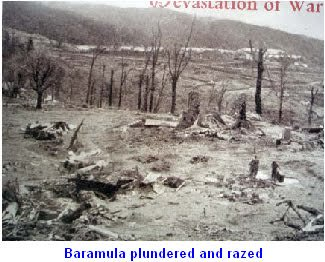
With the benefit of hindsight, it would seem that all stars had aligned in the best possible way to ensure a victory for own troops.
Everything had fallen into place beautifully - the arrival of the armoured cars, the sidestepping of the 1 Sikh boys towards the airfield after the Budgam incident a day prior & the rickety old bridge at Krahom sustaining the weight of the armoured cars!
The sights that awaited them in Baramula were horrific.
The town was completely deserted.
Everywhere there were signs of arson, pillage & wanton destruction. Patients in the Mission Hospital had been butchered in their beds, or dragged outside & killed,
The Mother Superior of the Mission Church & the nuns there had been murdered in the most horrific manner imaginable.
In fact, the likes of ISIS today might have found excellent motivation in what the tribal 'raiders' did to the town 72 years ago.
Survivors told the story of how the raiders suddenly appeared in the town on 27 Oct & took control, starting an orgy of rape & plunder. Throughout that day & night the southern part of the town, upto Jhelum River was plundered.
Next day the raiders crossed over to the Northern part of Baramula & abducted womenfolk whom they dragged across the river to the South, warning the men to stay in their houses or be killed.
By sheer providence & even better soldiering, Srinagar had been spared this horrific fate.
Upon hearing of the liberation of Baramula, Ghulam Bakshi Mohd decided to visit the town to calm down the populace.
His presence had a wonderful effect, finally letting the ppl believe they were indeed safe.
By evening, HQ 161 Brigade, 1 Sikh & 1(Para) Kumaon were in Baramula & 1/2 Punjab was at Pattan.
Troops required to defend Srinagar were set apart that day as 'Sri Force', including 4 Kumaon, 6 RajRif & 1 company of 2 Dogra under Col Harbaksh Singh.
A telegram from Gen Bucher congratulating the men under Maj Gen Kalwant Singh for their brilliant exploits thus far was received.
In the midst of this, info was received that some enemy personnel had infiltrated into Shopiyan area in Kulgam district, near Anantnag.
This was serious, if true because of the threat it posed to Banihal tunnel or the Ramban bridge - both very critical.
As a precaution, one platoon 3 (Para) Rajput was sent to Ramban from Jammu & a squadron of J&K Bodyguard Cavalry moved to Shopiyan.
In the meantime, there was no joy for the besieged troops on the other side of the Pir Panjal. Still hard pressed, many of them would fall in the days to come.
Some would be retaken, while others would be lost for good.
Mopping up operations around Baramula continued as own troops consolidated their positions on the high ground west of the town.
The RIAF flew 4 Tempest sorties from Amritsar over Baramula - Uri and Kotli - Rawalkot Areas. The Tempests successfully hit a despatch rider, several lorries & a bridge of boats near Muzaffarabad.
250-lb bombs were used for the first time in this area.
Spitfires from Srinagar also paid a visit to Kotli area & attacked targets indicated to them by the besieged State Forces men.
Sadly, however, the Bagh Garrison, unable to hold out any more, successfully withdrew to Poonch along with the refugees.
With them would come the stories of horrors at the hands of raiders, making an even stronger case for more forces in the area.
161 Brigade too, prepared to move out the next day, this day being spent reorganizing its troops.
Reorganization done, 161 Brigade moved out of Baramula towards Uri & thence to Domel at 7am.
It was, and still remains, a scenic route with a road winding its way Westwards along the south bank of Jhelum, flanked by majestic mountains.
But this day, the road was quite dangerous to move on due to intermittent fire from these very mountains.
1 Troop of armoured cars ex 7 Cav led the advance, followed by 1 Sikh & 1 Kumaon & finally, the arty.
1 Punjab was left behind to hand over defences to 2 Dogra & was to catch up thereafter.
Suddenly, a message flashed on the wireless from Maj Gen Kalwant Singh to send 1 Punjab back to Srinagar, from whereon it would move to Jammu to join the 50 Para Brigade.
With 161 Brigade already on the move, it became an awkward situation, esp given the terrain they were advancing in. However, all their pleas were turned down & 1 Punjab headed back to Srinagar.
A few days later it would find itself defending Jhangar, in yet another epic battle.
Will tweet about that in a few days.
161 Brigade encountered no opposition till Milestone 84 where they found a bridge blown & a platoon of enemy deployed with automatic weapons.
The opposition was brushed aside & a diversion made, resuming the advance.
The same story repeated near Milestone 79.
However with the enemy in strong positions & daylight fading, the brigade firmed in for the night, with plans to resume the next day.
That entire day & in the night, 161 'Son of a Gun' Brigade suffered only 1 casualty, sadly from friendly fire when a company commander of 1 Sikh lost his way at night & when returning to own positions, failed to reply to the challenge of a sentry.
He was shot by his own sentry, the bullet hitting his leg. Non fatal, but he had to be evacuated the next day.
The force remaining in Srinagar were now organised as 'Sri Garrison' under command Col Harbaksh Singh.
4 Kumaon, 6 RajRif & the squadron of 7 Cav less the troop with 161 Brigade formed the major part of this garrison.
Meanwhile, situation continued to be grim on the other side of the Pir Panjal.
Bagh garrison had already withdrawn to Poonch.
Other garrisons in the area too, were under huge stress.
Yet, all that could be managed were a few sorties by RIAF that day the maroon berets of Brig Paranjpe's 50 Para Brigade were still very far, it would be too late for some by the time they came.
Meanwhile, with the enemy on the run and the very real likelihood of a complete rout till Muzaffarabad and beyond, wheels in corridors of power in Delhi, London & Karachi started turning.
A lot of seemingly unrelated, minor incidents would ultimately prevent the successful recapture of Muzaffarabad, as well as a physical link up between Uri & Poonch via Haji Pir Pass the same way as Gilgit & Baltistan had been lost just 10 days earlier.
Even though a bloody battle was being fought in J&K, an even murkier game was being orchestrated on diplomatic / political chessboards much farther away. Unlike what some might want to believe, the Great Game was far from over.
With a common Viceroy for both dominions & British Commanders in Chief for both armies, a lot of leverage lay with London, something that they were happy to exploit towards their own interests, leaving the business of Kashmir unresolved till date.
Tempest sorties from Amritsar found Rawalkot & Bagh garrisons devoid of their defenders, & the enemy too was not to be seen. However, the aircraft did manage to spot some enemy personnel near Kotli, who were addressed with cannon & rocket fire.
A report in New York Times by Robert Trumbell after the liberation of Baramula stated, "The town had been stripped of its wealth & young women before the tribesmen fled in terror, at midnight Friday, before the advancing Indian army.
Survivors estimate that 3,000 of their fellow townsmen including four Europeans and a retired British Army Officer, known only as Colonel Dykes, and his pregnant wife, were slain.
A former town official said: 'The raiders forced 350 local Hindus local Hindus into a house, with the intention of burning it down. The group of 100 raiders is said to be holding another 5 as hostages, on a high mountain,barely visible from the town.
Today 24 hours after the Indian army entered Baramulla, only 1,000 were left of a normal population of about 14,000." (Trumbell 1947, cited in Brecher 1953:28)
A heroic story too emerged from Baramula, that of an NC activist, Md Maqbool Sherwani. He had managed to delay the raiders by planting rumours / misguiding them when asked for directions.
He rallied the residents & even managed to get some raiders captured by the Indian Army. However, his luck ran out a day before the liberation of Baramula & he was captured.
The tribesmen took Sherwani to the stoop of a little apple shop in the town square of Baramula, and the terrified townspeople were driven into the square in front of him with the butts of rifles.
Knowing his popularity, he was ordered by his captors to make a public announcement that joining Pakistan was the best solution for Muslims.
When he refused, he was lashed to the porch posts with ropes, his arms spread out in the shape of a cross, and he was told he must shout "Pakistan Zindabad, Sher-i-Kashmir [Sheikh Mohammed Abdullah] Murdabad."
He refused.
He was asked to do so once again.
They drove nails through the palms of his hands when he refused again.
On his forehead they pressed a jagged piece of tin and wrote on it: "Punishment of a traitor is death"
Once more he cried out, "Victory to Hindu-Muslim unity."
14 tribesmen shot bullets into his body. (Bourke-White 1949:210-211)
Every Infantry Day, Indian Army commemorates Maqbool Sherwani. It has also constructed a Memorial Hall in his name in Baramula.
Sadly, it seems that not many of the present day townsfolk deem it necessary to remember a man who probably saved their grandparents in 1947
Meanwhile, 161 Brigade had resumed its advance in the morning from Milestone 44 where it had plonked the night prior.
The advance began with an attack to dislodge the enemy from where he had held up own troops the last night.
However, before the attackers could close in, the enemy withdrew.
This would be the template for the day - delaying tactics.
Advancing thus, the brigade reached Rampur by 4pm & was preparing to camp for the night.
However, a sudden explosion was heard in the distance.
A quick appreciation of the situation led to the conclusion that the enemy were busy destroying the Mahura Power Station as own troops closed in.
Abandoning all thoughts of rest, 161 Brigade quickly organized itself for an attack on the raiders to save the power plant
A flanking attack was planned & 1 Kumaon ordered to attack the enemy from a nearby hill.
As the Kumaonis were climbing up, they were spotted by the enemy, who tried to engage them with heavy automatic fire.
However, the fire was ineffective & realizing that a strong attack was developing, he prepared to withdraw from his positions.
Amazingly, the Pakistan Army has continued to follow this policy even today, 72 years later!
However, in the process of withdrawing, 5 uniformed individuals, including 3 officers, appeared on the main road up ahead.
However, in the process of withdrawing, five uniformed individuals, including 3 officers, appeared on the main road up ahead.
As they rushed to get into a khaki staff car parked nearby, an Indian armoured car had already taken aim with its 2 inch main gun.
Their time was up.
As the Paki officers entered their car, the gun of the Diamler Armoured Car boomed & scored a direct hit.
The poor sods were dispatched to their maker with clinical precision.
As 1 Kumaon closed in with the objective, they realised that the coward enemy had fled. An inspection of the power house revealed a large amount of explosives, detonators, fuzes littered all over the place.
Out of the 3 generators, 1 was damaged, another being prepared for destruction & the 3rd one intact. But a liberal amount of sand had been thrown into the working parts.
Still, the equipment was salvageable & power generation recommenced within weeks, lighting up Srinagar once again - A hugely symbolic gesture since lights had gone out a month earlier.

